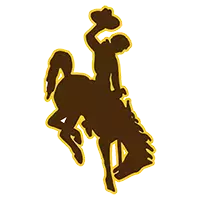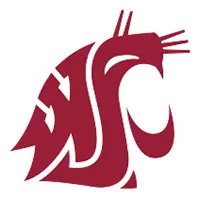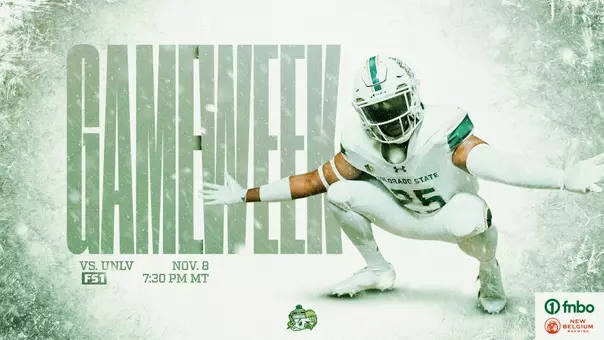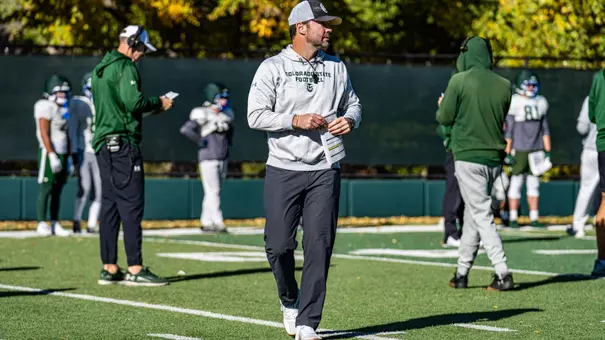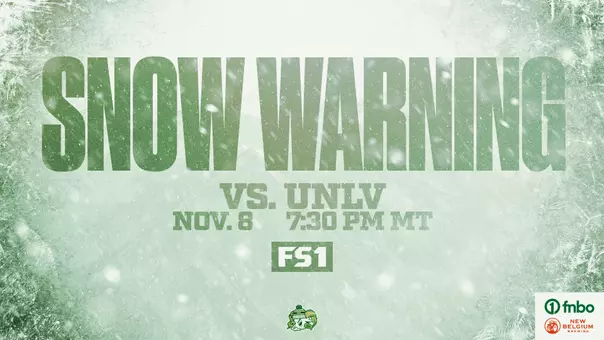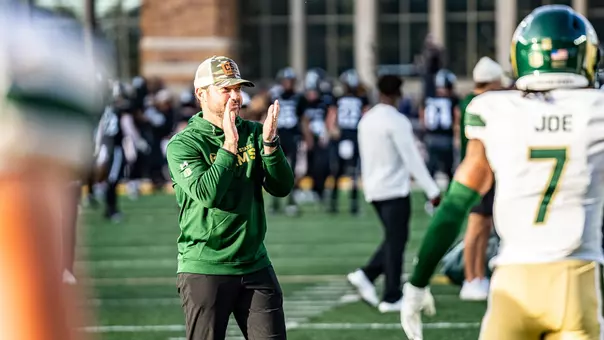Colorado State University Athletics

Memorable Moments: Hanna’s Legacy Continues with Program
9/19/2024 2:00:00 PM | Football
Stalwart back’s early death sent shockwaves through team
Earlier this year, CSU honored the legendary John Mosley by retiring his No. 14 across all sports as a thanks to his enduring courage to bring diversity to the campus. While many fans, and even Colorado sports historians, know a lot about the first modern day Black football player turned Tuskegee Airman and military hero, time has elapsed to the point few know what Eddie Hanna did for Colorado State and why his No. 21 is retired.
For more than 22 years I sat in the 57th row of Hughes Stadium, directly under Eddie Hanna's name on the press box. When I told fans where I sat, I would say, "Just under Eddie Hanna's name and retired number." The typical reaction was, "Oh yeah, who was Eddie Hanna?"
As a historian who has been close to the Hanna family with a promise the keep his memory known at CSU, the 75th anniversary of his uniform number retirement is a perfect moment to reflect on another Black athlete who made history at what was then known as Colorado A&M.
Hanna was born in Great Bend, Kan., on February 20, 1925, but he was raised and played high school sports in Dodge City, Kan. He served in the Army Air Corps during WWII as a corporal with the 461st AAF Aviation Squad, a heavy bomber replacement unit which served the Pacific Theatre of war.
After the war, Hanna enrolled at Dodge City Junior College (Today's Dodge City Community College) and lettered in football, track and basketball. Colorado A&M head coach Bob Davis heard about this small, but shifty halfback from Kansas, and just two days before the 1947 football season, brought him to Fort Collins to play for the Aggies. Hanna was not the only Black player on a predominantly white football team, George Jones from the Denver area came to play for A&M in 1946, helping Hanna in a new town which still had plenty of racism among the citizens and students.
Hanna was an immediate success on the team, making long rushes with his 5-foot 9 frame low to the ground. Not only did Hanna catch the eyes of the football community, he became popular on the campus as well. While Mosely and his fellow African-American students were unable to live on campus, Hanna eventually had his own program on the campus radio station. He was frequently featured in the Collegian student paper and among his peers earned the nickname "Twikletoes" thanks to his ability to cut and run long distances.
By the 1948 season, Hanna's rushing had caught the attention of not just the Denver sports writers, but some national sports writers had realized this Colorado A&M team had an amazing halfback. He was being compared to other halfbacks across the nation and was the key to their 1948 team nearly winning the conference championship. That 1948 success on the field earned the Aggies (or Rams as some were calling them) an invitation to the January 1, 1949, Raisin Bowl.
Hanna did not disappoint the fans in Fresno at the Raisin Bowl and scored two touchdowns of more than 70 yards in the bowl game -- still a CSU record for a running back scoring two 70-plus-yard touchdowns in one bowl game. While the A&M team lost by one blocked extra point kick, Hanna's charm and being loved by his teammates was at an all-time high.
By the 1949 season, Hanna and Frank Faucett were set up as a tough halfback combination for coach Bob Davis' third season at the helm. The season opened in Colorado Springs against the Colorado College Tigers on Sept. 17 for what was expected to be an easy game. The first half had proven easy, with Faucett leading the rushing but out due to a hip injury. Hanna, who had not felt well the previous day, felt he had been hit in the chest and approached team doctor Duane Hartshorn to tell him he was short of breath and had a burning sensation in his chest.
Hartshorn and Davis took Hanna out of the game too, knowing it was not a tough contest and backups like Jack Christiansen could fill in for Hanna and Faucett. After the game, Hanna sat in the locker room and next to him was Lee Walters. In a 2008 interview with Walters, he said, "Eddie sat next to me and said, 'Man this puppy really hurts, help me take off my jersey.'" Walters remembered his teammate as one of the nicest people in the school, and all the men in the locker room knew something was wrong with him.
As the team boarded their special train cars for the ride back to Fort Collins, they were told to move to the dining car for some food. It was a night game and by 11 p.m., the cars were finally ready to connect with the rest of the train back home. Players were tired and hungry, but as Hanna got up from his seat, he collapsed onto the floor and was taken to another car where he was pronounced dead at 11:17 p.m., by Doc Hartshorn. The team was in shock on their ride back to Fort Collins, a 24-year-old athlete like Hanna should not have died so suddenly.
Another shock awaited the Colorado A&M team in Fort Collins when they were greeted at the train station. Several former players have said in various interviews while Hanna had been a highly popular student on the campus, no local funeral home would take his body off the train simply because he was Black. His teammates had to remove his body from the train so it could be taken to a funeral home that accepted his race. Even in death, at a time when so many fans in Fort Collins cheered him, he was discriminated against because of his skin color.
On Sept. 23, 1949, Bob Davis, student body president and future governor of Colorado Roy Romer, along with college representative Jasper French traveled to Dodge City, Kans., to the funeral of Eddie Hanna. A scholarship fund was established, the team helped pay for his gravestone which has a football and "Colo A&M" on it, and his No. 21 was retired in honor of their fallen player. While CSU has had other players die while on the team, Hanna is the only one to die during the football season. He is the only player to have his number retired due to his sudden death. His cause of death was a heart attack, though it is unknown if it resulted from a hit to the chest.
For 75 years, CSU has honored this beloved player by keeping his uniform number retired and shown on the stadium press box. At one time in the past 25 years, a transfer student had asked for and was later required that he get to wear No. 21 because he had always worn that number at his old school. After the school refused to let this player wear it several times, he would not give in until he met with Eddie Hanna's sister in Denver. Shortly after his meeting with Hanna's sister, the player never asked for the number again. Even in modern times, it is understood that remembering a player is more important than just a number.
For more than 22 years I sat in the 57th row of Hughes Stadium, directly under Eddie Hanna's name on the press box. When I told fans where I sat, I would say, "Just under Eddie Hanna's name and retired number." The typical reaction was, "Oh yeah, who was Eddie Hanna?"
As a historian who has been close to the Hanna family with a promise the keep his memory known at CSU, the 75th anniversary of his uniform number retirement is a perfect moment to reflect on another Black athlete who made history at what was then known as Colorado A&M.
Hanna was born in Great Bend, Kan., on February 20, 1925, but he was raised and played high school sports in Dodge City, Kan. He served in the Army Air Corps during WWII as a corporal with the 461st AAF Aviation Squad, a heavy bomber replacement unit which served the Pacific Theatre of war.
After the war, Hanna enrolled at Dodge City Junior College (Today's Dodge City Community College) and lettered in football, track and basketball. Colorado A&M head coach Bob Davis heard about this small, but shifty halfback from Kansas, and just two days before the 1947 football season, brought him to Fort Collins to play for the Aggies. Hanna was not the only Black player on a predominantly white football team, George Jones from the Denver area came to play for A&M in 1946, helping Hanna in a new town which still had plenty of racism among the citizens and students.
Hanna was an immediate success on the team, making long rushes with his 5-foot 9 frame low to the ground. Not only did Hanna catch the eyes of the football community, he became popular on the campus as well. While Mosely and his fellow African-American students were unable to live on campus, Hanna eventually had his own program on the campus radio station. He was frequently featured in the Collegian student paper and among his peers earned the nickname "Twikletoes" thanks to his ability to cut and run long distances.
By the 1948 season, Hanna's rushing had caught the attention of not just the Denver sports writers, but some national sports writers had realized this Colorado A&M team had an amazing halfback. He was being compared to other halfbacks across the nation and was the key to their 1948 team nearly winning the conference championship. That 1948 success on the field earned the Aggies (or Rams as some were calling them) an invitation to the January 1, 1949, Raisin Bowl.
Hanna did not disappoint the fans in Fresno at the Raisin Bowl and scored two touchdowns of more than 70 yards in the bowl game -- still a CSU record for a running back scoring two 70-plus-yard touchdowns in one bowl game. While the A&M team lost by one blocked extra point kick, Hanna's charm and being loved by his teammates was at an all-time high.
By the 1949 season, Hanna and Frank Faucett were set up as a tough halfback combination for coach Bob Davis' third season at the helm. The season opened in Colorado Springs against the Colorado College Tigers on Sept. 17 for what was expected to be an easy game. The first half had proven easy, with Faucett leading the rushing but out due to a hip injury. Hanna, who had not felt well the previous day, felt he had been hit in the chest and approached team doctor Duane Hartshorn to tell him he was short of breath and had a burning sensation in his chest.
Hartshorn and Davis took Hanna out of the game too, knowing it was not a tough contest and backups like Jack Christiansen could fill in for Hanna and Faucett. After the game, Hanna sat in the locker room and next to him was Lee Walters. In a 2008 interview with Walters, he said, "Eddie sat next to me and said, 'Man this puppy really hurts, help me take off my jersey.'" Walters remembered his teammate as one of the nicest people in the school, and all the men in the locker room knew something was wrong with him.
As the team boarded their special train cars for the ride back to Fort Collins, they were told to move to the dining car for some food. It was a night game and by 11 p.m., the cars were finally ready to connect with the rest of the train back home. Players were tired and hungry, but as Hanna got up from his seat, he collapsed onto the floor and was taken to another car where he was pronounced dead at 11:17 p.m., by Doc Hartshorn. The team was in shock on their ride back to Fort Collins, a 24-year-old athlete like Hanna should not have died so suddenly.
Another shock awaited the Colorado A&M team in Fort Collins when they were greeted at the train station. Several former players have said in various interviews while Hanna had been a highly popular student on the campus, no local funeral home would take his body off the train simply because he was Black. His teammates had to remove his body from the train so it could be taken to a funeral home that accepted his race. Even in death, at a time when so many fans in Fort Collins cheered him, he was discriminated against because of his skin color.
On Sept. 23, 1949, Bob Davis, student body president and future governor of Colorado Roy Romer, along with college representative Jasper French traveled to Dodge City, Kans., to the funeral of Eddie Hanna. A scholarship fund was established, the team helped pay for his gravestone which has a football and "Colo A&M" on it, and his No. 21 was retired in honor of their fallen player. While CSU has had other players die while on the team, Hanna is the only one to die during the football season. He is the only player to have his number retired due to his sudden death. His cause of death was a heart attack, though it is unknown if it resulted from a hit to the chest.
For 75 years, CSU has honored this beloved player by keeping his uniform number retired and shown on the stadium press box. At one time in the past 25 years, a transfer student had asked for and was later required that he get to wear No. 21 because he had always worn that number at his old school. After the school refused to let this player wear it several times, he would not give in until he met with Eddie Hanna's sister in Denver. Shortly after his meeting with Hanna's sister, the player never asked for the number again. Even in modern times, it is understood that remembering a player is more important than just a number.
Colorado State Football: Tyson Summers Weekly Press Conference - Week 9 (2025)
Monday, November 03
Colorado State Football: Lanier (L) and Mitchell (R) Post-Game (Wyoming, 2025)
Monday, October 27
Colorado State Football: Tyson Summers Post-Game (Wyoming, 2025)
Monday, October 27
Colorado State Football: Owen Long - Outstanding By Any Measure
Wednesday, October 22






